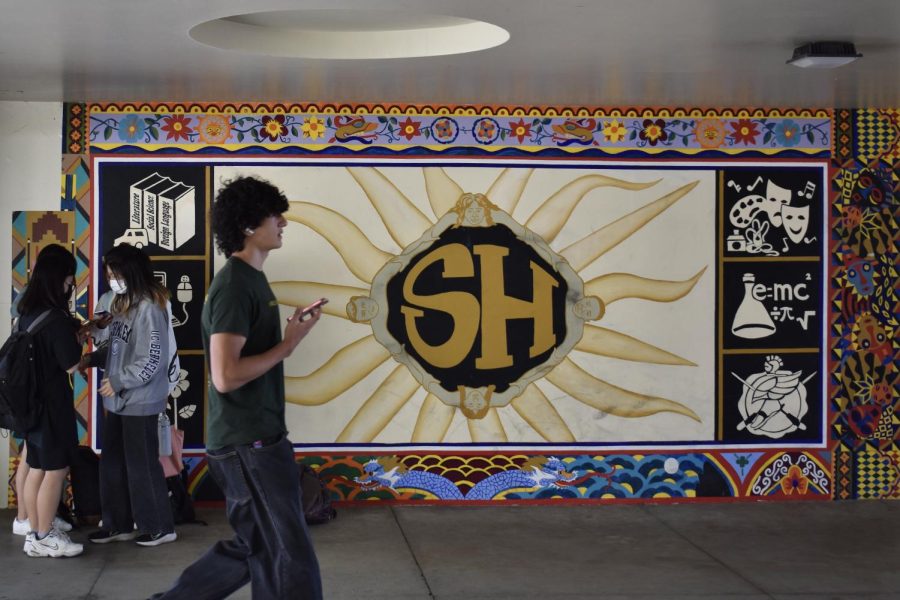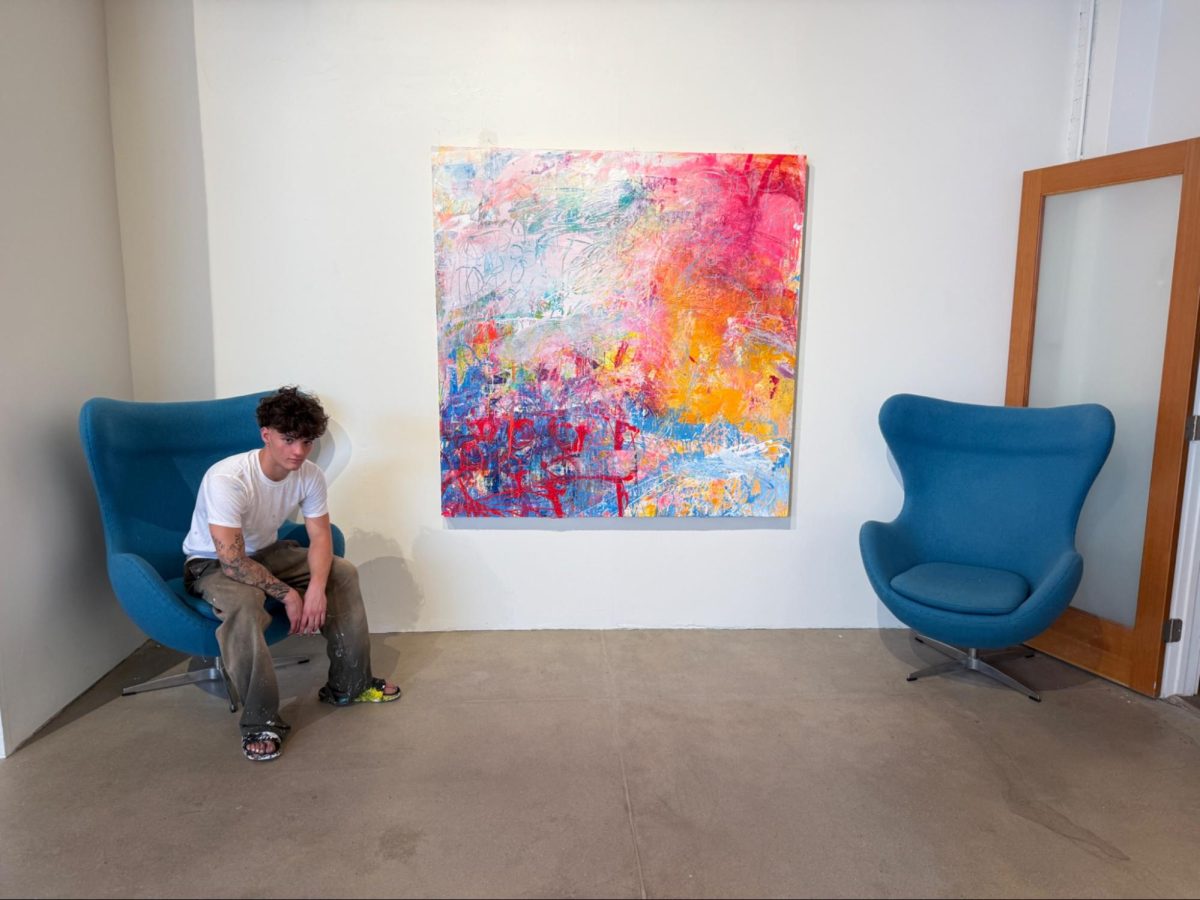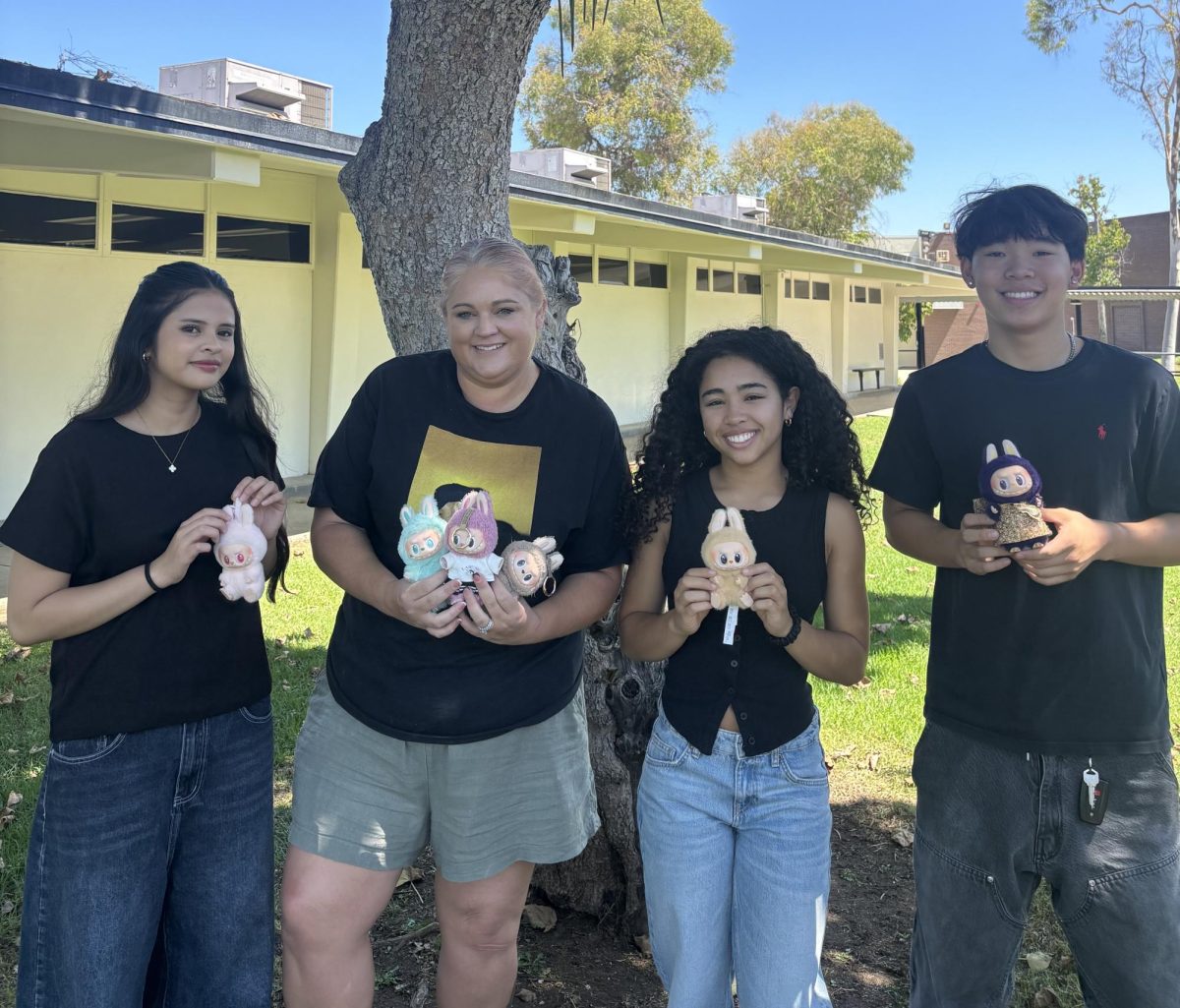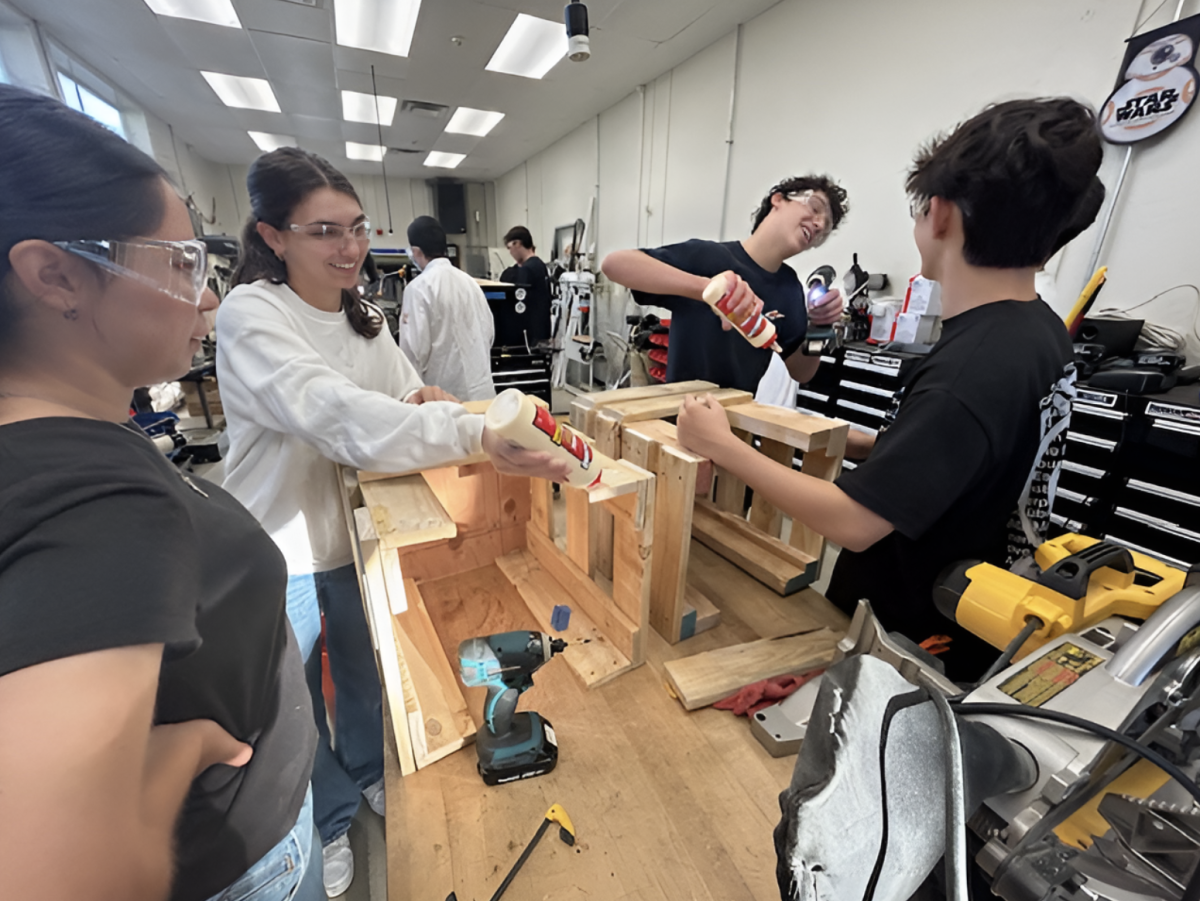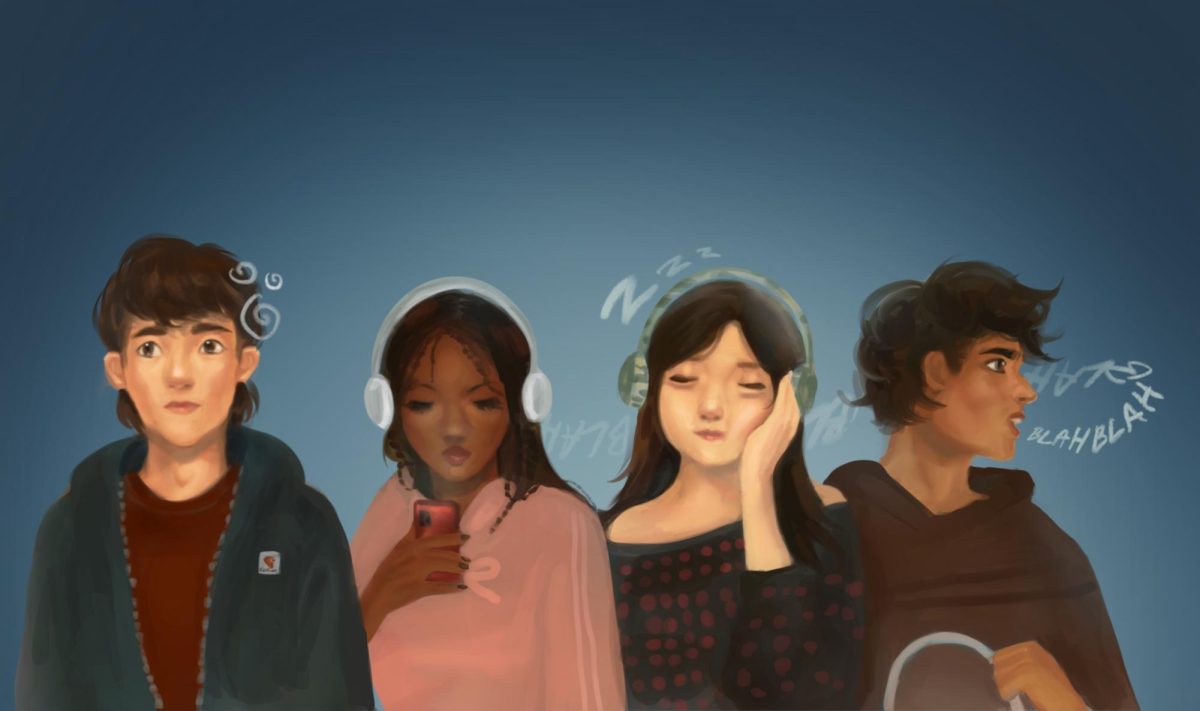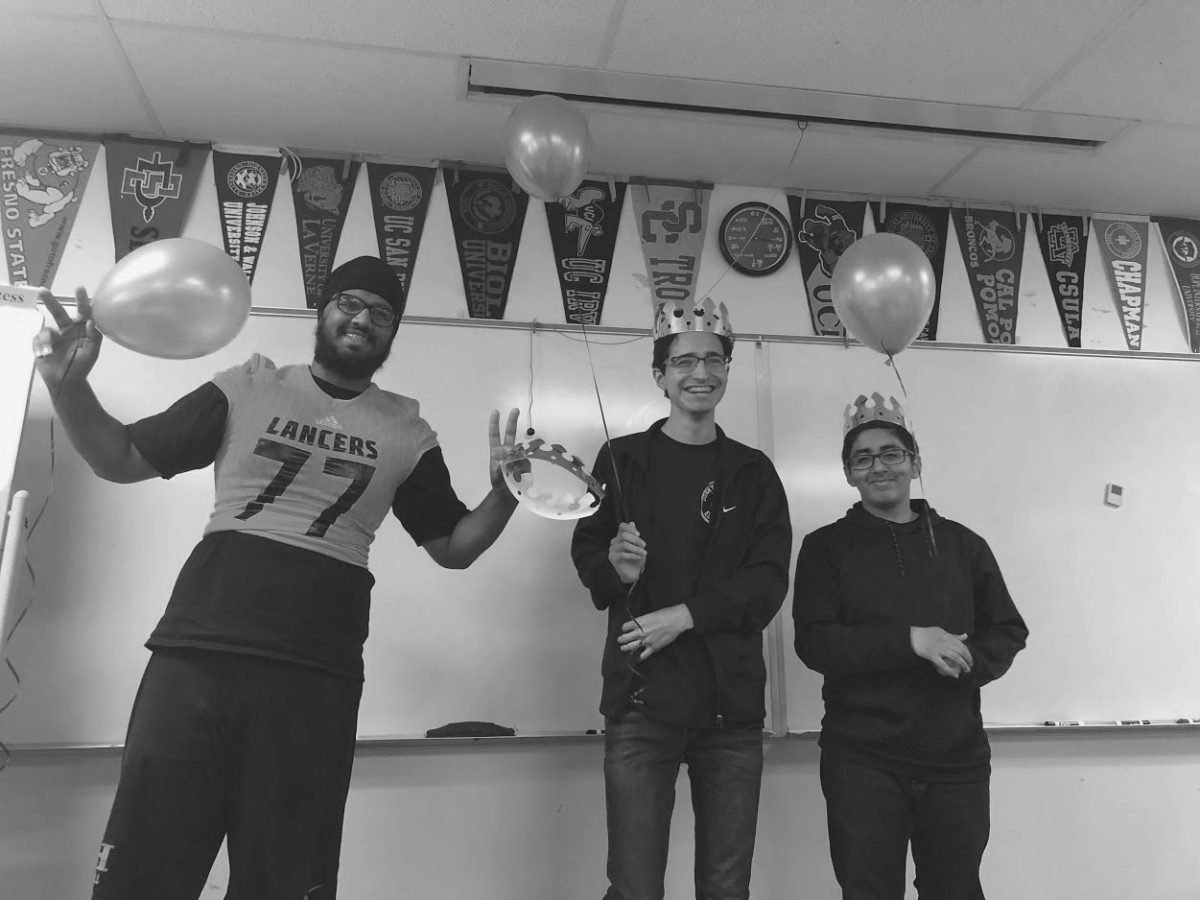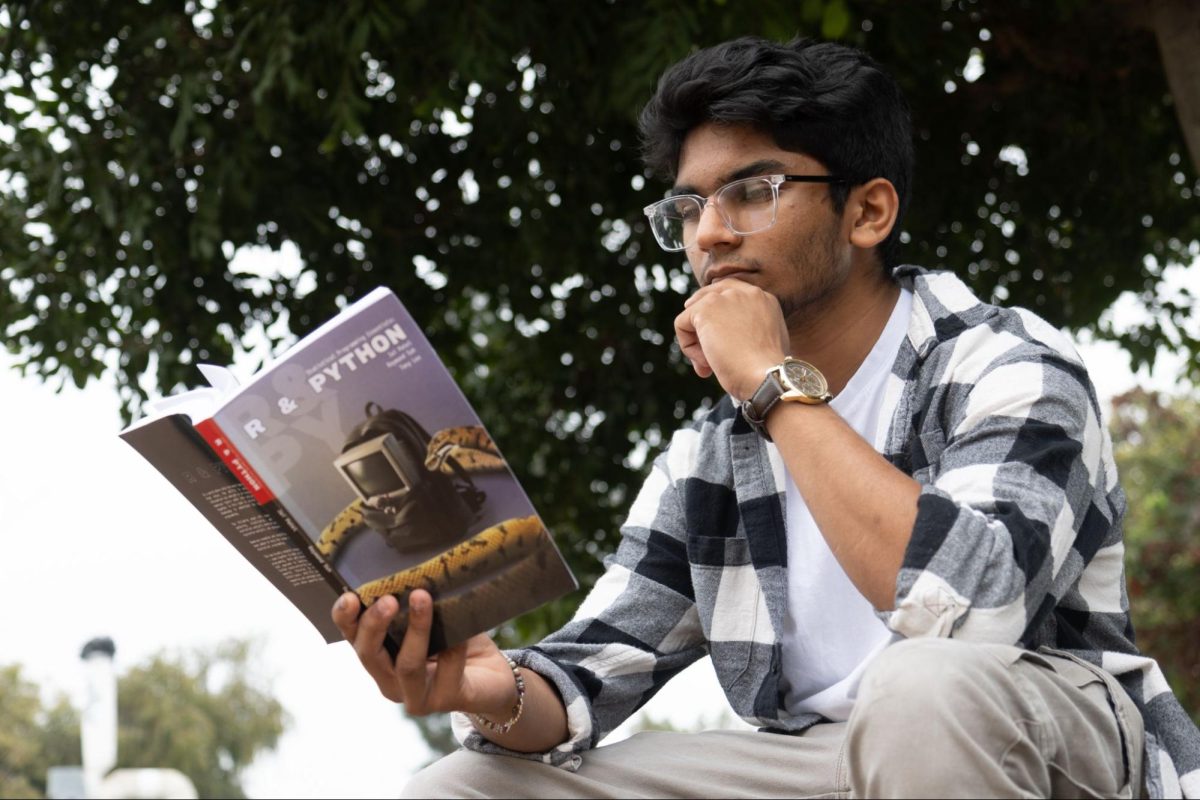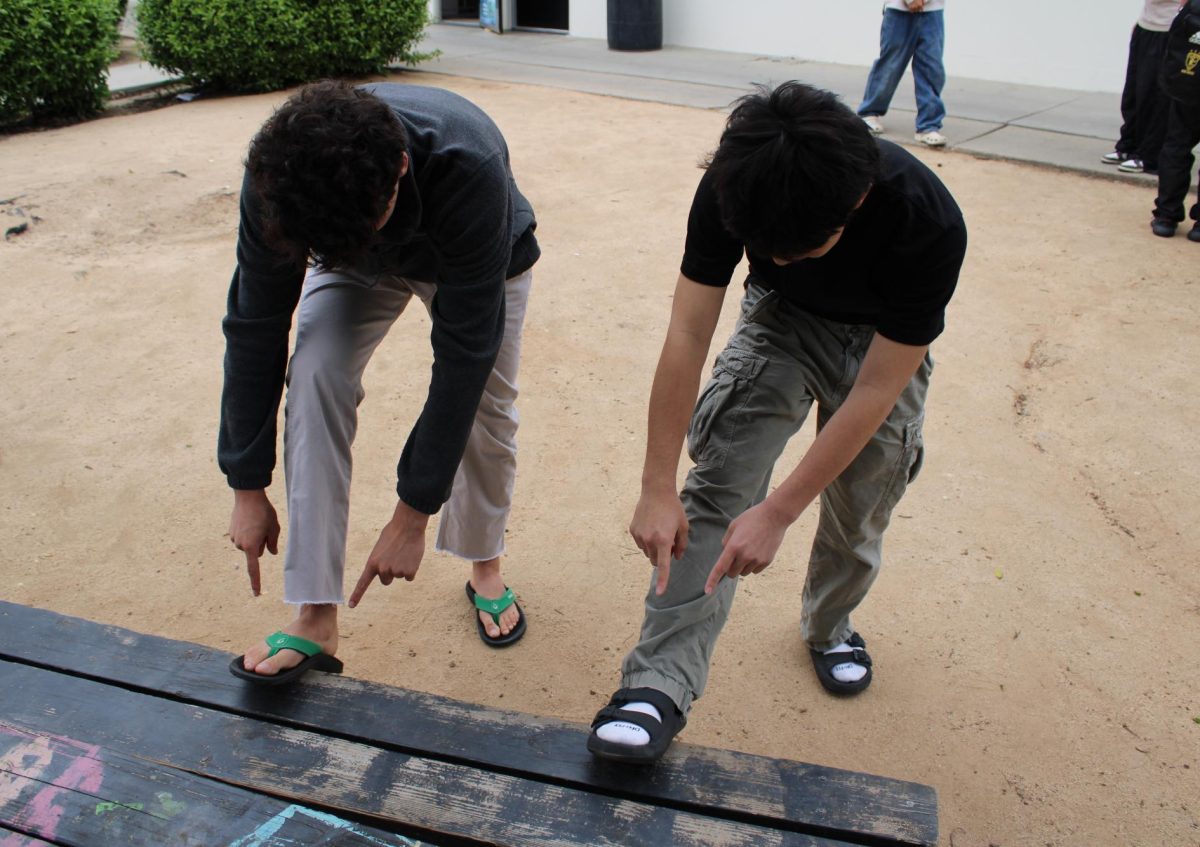As a continuing feature from last semester, The Accolade investigates some of the mysterious spots on campus. For this issue, we look into the origins of the breezeway mural in between the 10s and 20s wings. How did the painting end up there? What purpose did it serve? Who originally came up with the idea for a mural, and who painted it? The Accolade sends news editor Susie Kim to investigate.
The letters “SH” stand out as the focal point.
Painted in gold with a black background – school colors – the serif fonts the size of a hula hoop represent the words, Sunny Hills. They are also drawn to make it look as if the letters illustrate the core of a sun.
Two female and two male figures link arms around that core, forming the center of 15 gold rays from a bird’s eye point of view as if viewed from a drone.
Six black squares with symbols including textbooks, computers and a Lancer painted in white depict various school activities and surround the interior of a border framed with geometric shapes to resemble flowers with green vines.
Finally, two blue dragons rest on the bottom.
These images come together to portray a colorful mural standing at about 15.5 feet wide by seven feet tall, nearly equal in size to the 20-foot-by-10-foot jumbotron on the wall of the campus’ only two-story building.
But do any Sunny Hills students entering or leaving the campus through the breezeway between the main office in the 10s wing and the 20s wing ever notice such a work of art or wonder about how it got there and its purpose?
“I occasionally noticed the mural, but never paid close attention to it,” said junior Shaharil Zaman, who was unaware of the origin behind the artwork. “I would guess that the mural was painted about about six years ago because of its slightly worn-out color.”
Though she sits on the bench facing the wall every day during lunch, sophomore Eloriana Castaneda said the painting has never really caught her eye to the point of wanting to know more about its origins.
“I just see it there and think that it looks nice,” Castaneda said. “I’ve never really considered where it came from or about its origin.”
MR. WALL TALKS ABOUT THAT MURAL ON THE WALL
No, this is not the new drawing the Art Club painted last school year on the Performing Arts Center wall.
Rather, it’s the one Conservatory of Fine Arts director and Art Club adviser Brian Wall started with former art teacher Cathy Lischerelli in 1996 – 26 years ago.

As a fifth-year teacher on campus, Wall said Lischerelli invited him to collaborate with Advanced Placement and International Baccalaureate art students to produce the painting.
“She was trying to teach kids the same process that was used to create the paintings in the Sistine Chapel by Michelangelo,” said Wall, who recalls the project took about two and a half months to complete. “They walked away understanding what Michelangelo kind of went through to make this little mural in comparison to the giant things he made.”
The team incorporated a technique called pouncing, which involves pasting charcoal onto a sketched sheet with tiny holes to outline the images. This left a traced reference for the painters to illustrate the mural, he said.
“The mural is a testament to the quality of how well it was made,” Wall said. “The paint has stuff that makes it protected from [ultraviolet] damage, and it definitely looks as vibrant as when it was first made.”
Though no record of this project was published in The Accolade’s bound issues from 1996, and none of the main artists have any pictures of them working on it, the completed mural shows up twice in the 414-page school yearbook, Helios.
On page 266, the Associated Student Body officers representing the Class of 1997 simulate their own version of the unity circle in front of the painting.
And then on page 395, this caption was printed above the artwork: “Mural–A Celebration of Diversity on Campus by the students of Special Studies & other art classes.”
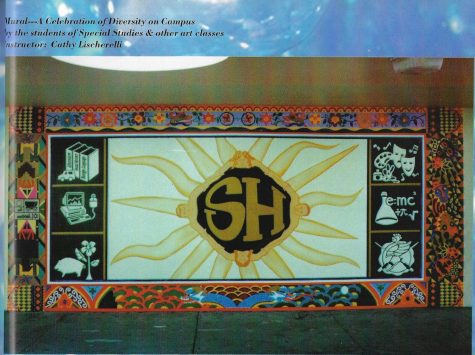
FROM ONE RAPHAEL TO ANOTHER
Then-senior Joseph Raphael, who ironically has the same last name as Italian Renaissance painter Raphael, was among the Special Studies art students in Lischerelli’s class in 1996.
Raphael said he took the lead and guided the entire mural-painting process — from planning, sketching and putting the project to life on the breezeway wall.
But he also had help. His peers, then-seniors Hillina Jarso and Jennifer Pak and then-junior Dawn Geftakys (who now goes by Dawn Shanks), were among the few who voluntarily took part in brainstorming ideas for each element depicted in the mural, placing an emphasis on portraying campus diversity and unity, said Raphael, who’s now a licensed marriage and family therapist working in Montrose in Los Angeles County.

“I remember hours outside of ‘school’ having limited resources and numerous design revisions. … We attempted to capture culture [like with the blue dragons], diversity, equity, ethnicity and pillars consistent to Sunny Hills,” he said in an email interview.
Shanks said she actually earned a $1,000 scholarship from her contributions to the mural.
The mural painting team had submitted multiple sketches during the initial planning of the project, and Lischerelli combined the top few ideas into what is currently visible today, she said.
Shanks recalled taking responsibility for the centerpiece, hoping to convey SH’s diversity with the figures’ distinct facial features and unity through their linked arms.
She hoped to bring the connectedness all back home by drawing rays to represent “Sunny” Hills.
“Knowing that the mural is still standing makes me happy,” she said. “I just remember painting it after school with people and laughing and talking. … It was just a lot of fun.”
Despite all their time and effort, none of them thought about documenting the different stages that went into completing the artwork.
“We did not remember any [unveiling] ceremony,” Raphael said. “We do not have pictures from working on the mural.”
CRIME STRIKES ON THAT WALL IN THE 1980S
Little did the artists know they were painting over a history of vandalism.
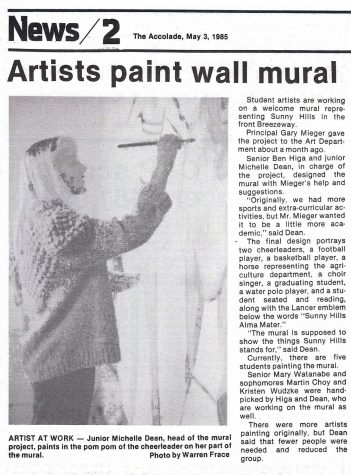
Just seven years before Wall encountered the blank wall, the 1985 Art Department started its project on the same canvas.
Aiming to paint a sign of welcome on campus, the students at the time portrayed a series of school activities, including drawings of cheerleaders, football players and a horse to represent the agriculture department.
“Originally, we had more sports and extracurricular activities, but [former principal Gary Mieger] wanted it to be a little more academic,” head of the project and then-senior Ben Higa told The Accolade in a May 1985 article. “The mural is supposed to show the things Sunny Hills stands for.”
Though the story provides a photograph of then-junior Michelle Dean painting the pompom of a cheerleader, Dean and Higa’s visions for the wall were never fulfilled.
“What I remember most about the mural is the scandal that went along with it,” said Suzie Beining, Class of 1988 alumna and current Parent Teacher Student Association parliamentarian who was a freshman at the time. “In my mind, I had visualized someone taking a paint roller and going over it with red and white streaks.”
The students working on the halfway-done mural halted their project after more than two instances of the same vandalism, she said. For the rest of her high school years, the breezeway consisted of a blank vanilla-colored wall.
“I have a vague recollection of the principal letting us know that the students were painting over the mural and that it was done,” Beining said. “I don’t really remember, but he probably announced it through the morning announcements.”
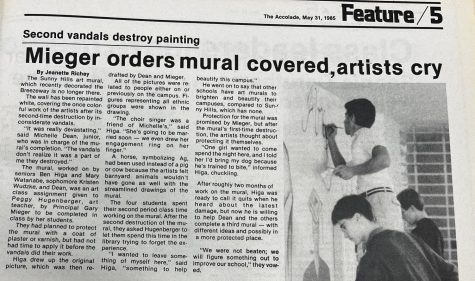
Beining’s then-high school friend and current SH social science teacher Hera Kwon said she didn’t retain any knowledge of the original mural but frequently sees the nearly 30-year-old painting while walking around campus.
“I think it’s definitely the mural that was supposed to be on that wall, despite the sad, sad story of the original mural,” said Kwon, after The Accolade informed her of the previously vandalized project. “From my recollection [of the current mural], it’s supposed to represent all the different elements of Sunny Hills High School — the academics and culture because of all the dragons and flowers.”
The Accolade covered the second and final destruction of the mural in a May 31, 1985, article, explaining the former artists’ wishes to protect the mural with a coat of plaster or varnish before its second case of vandalism.
“It was really devastating,” said Dean in the 1985 article. “The vandals don’t realize it was a part of me they destroyed.”
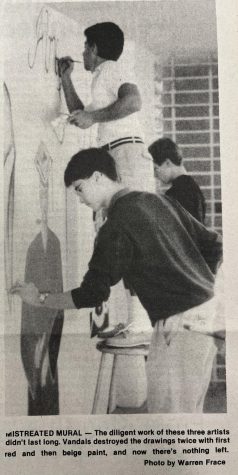
Dean, Higa, then-senior Mary Wantanabe and then-sophomore Kristen Wudzke spent most of their second period class working on the mural but asked former art teacher Peggy Hugenberger to let them reflect in the library after the vandals’ second markup of the wall.
“I wanted to leave something of myself here,” Higa said. “Something to help beautify this campus.”
MURAL STILL INSPIRES
Sophomore Vivian Pop also noticed other details of the painting from the past, including the still intact quality of its paint, estimating the art was painted recently — about five or 10 years ago.
“When I look at the mural, I think that it represents all the different classes that people take at Sunny Hills,” said Pop, who routinely passes by the mural during break. “I definitely see the different aspects of the subjects, like the arts, agriculture, math and science.”
She revealed similar feelings as Kwon for the 1996 painting after learning that Wall, her Special Studies second period teacher, participated in its production.
“I think it’s awesome that Mr. Wall contributed to the campus [in that way],” she said. “I think it added to the school atmosphere and made it a more beautiful place.”
Castaneda said she believes the mural has been free of vandalism for nearly three decades because of its significance in portraying the school academics and arts.
“It’s probably still in good shape because of the deep meaning it conveys,” she said. “I also think its presence is even more important knowing that the mural was repainted a few times because of the [1980s] scandal.”
So next time anyone walks past the breezeway, remember it’ll be the mural’s 30th year there in the next four years, and no signs of vandalism yet – at least none reported by The Accolade.
If you have suggestions for our next “Did You Know?” story, please send an email to [email protected], and we will send a reporter to investigate.




